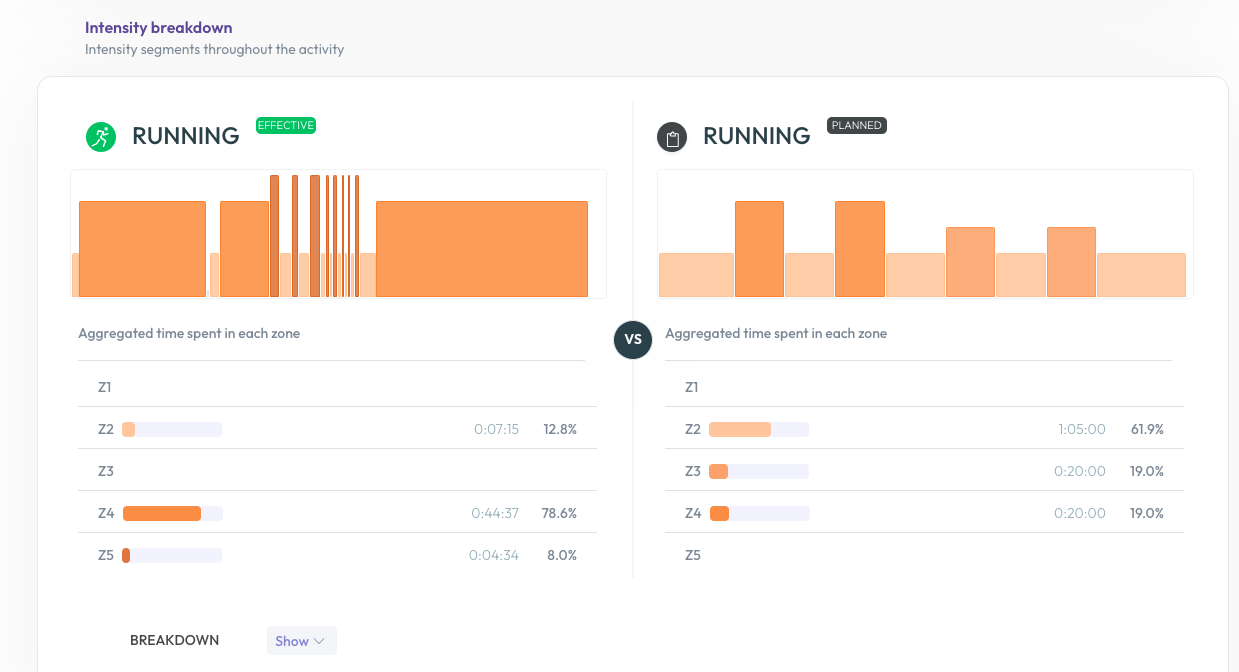What’s behind a smart training plan? This article walks you through the core concepts of training with 2PEAK – from periodization and training zones to performance tests. You’ll learn how to plan your season strategically, but also how to read and understand your workout descriptions on the platform. On top of that, it introduces advanced tools, helping you tailor your training based on your unique strengths and goals.
How to plan your season in 2PEAK?
Planning your season effectively is crucial for achieving peak performance at the right time. Here’s how to structure your training with 2PEAK:
- Set Your Main Race: Identify your primary event and enter it into your 2PEAK account under “Race & Goals.” This allows 2PEAK to tailor a training plan aimed at optimizing your performance for that specific date.
- Understand Race Priorities:
– Main Races: These are your top-priority events, requiring 4 to 12 weeks of specific preparation and 1 to 2 weeks of post-event recovery. Plan only one main race per peak period to maintain focus.
– B-Events: Important but secondary races that need only a few days of preparation and recovery. Schedule them in the weeks following a main event or at least four weeks before, to avoid disrupting your training cycle.
– Training Races: Used as intense workouts under race conditions, these don’t require specific preparation and fit into your regular training plan. They are ideal during intensity phases leading up to your main race.
- Periodize Your Training: Divide your training into distinct phases—endurance, intensity, and recovery—to systematically build fitness. This approach, known as periodization, helps in optimizing adaptation and continuous progress.
- Plan Training Camps Wisely: If incorporating a training camp, ensure it concludes no later than six weeks before your main race. This timing allows for adequate recovery and integration of the camp’s benefits into your overall training plan.
- Make the most of 2PEAK’s Dynamic Planning: 2PEAK’s adaptive training plans adjust to your goals, availability, and progress. Regularly update your plan with any new races or changes in your schedule to keep your training aligned with your objectives.
By following these steps and leveraging 2PEAK’s tools, you can structure your season to reach peak performance at your key events. You find more information in our blog article: How to plan your season with 2PEAK
Periodization
Periodization is the systematic division of your training into specific cycles—micro, meso, and macro—that focus on endurance, intensity, and recovery. This structured approach optimizes adaptation, ensuring continuous progress and peak performance. More information here: What is periodization?
Upcoming training description
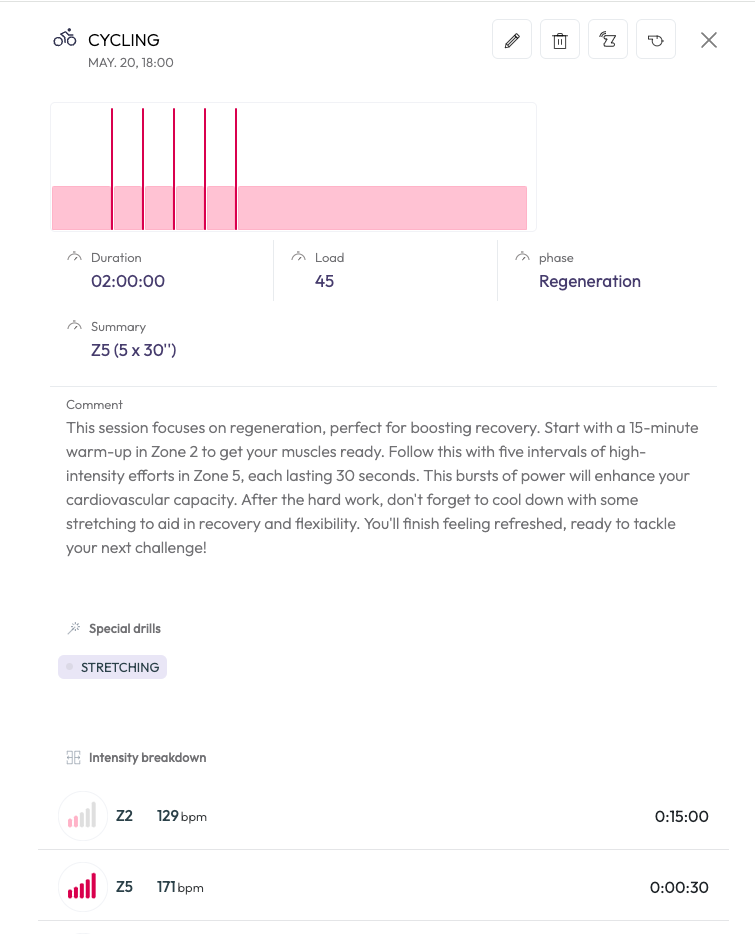
This is an example of what a workout overview looks like. In the top left corner, you’ll see the sport, date, and start time of your session. In the top right corner, you can edit or delete the workout.
Next, the visualization of the workout’s intensity zones is displayed, followed by the session’s duration, load, and the specific intensity phase within your training plan.
For users with an UNLIMITED subscription, your AI Coach provides a short, personalized description of the workout to guide you.
Just below, you can see the “Special drill” assigned to the training session. You can choose to modify it or add different focus points. Each sport has its own specific special exercises. By hovering over the “i” information icon on the right, you can read the detailed description of the special exercise.
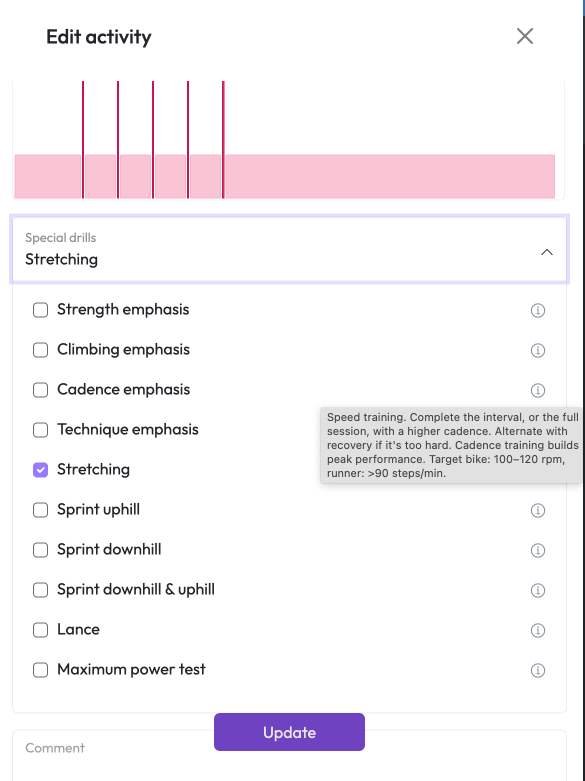
Finally, at the bottom, you’ll find a detailed breakdown of intensity zones, including the corresponding heart rate (bpm), duration of effort, and a clear visual representation of the workout structure.
Done training description
This is the description of a completed workout. Click on the workout in your calendar to access the detailed analysis page.
Workout Overview
In the right-hand menu, you will find the following buttons:
- Edit Activity: Modify your activity data if needed.
- Interval Detection: Visualize intensity zones for your workout based on different metrics (heart rate, pace, or power). The primary metric will depend on the sport you performed, as defined in your settings and training zones. Additionally, you can set a tolerance percentage (0%, 10%, 20%, 30%) to fine-tune how intervals are detected based on variations in effort.
- Unlink: Dissociate a recorded workout from the planned one. For instance, if your watch detected a commute ride and added it to your 2PEAK plan, you can unlink it if it doesn’t align with the scheduled activity.
- Download File: Export your activity file.
- Print: Generate a printable summary of the activity.
- Delete: Remove the activity from your calendar.
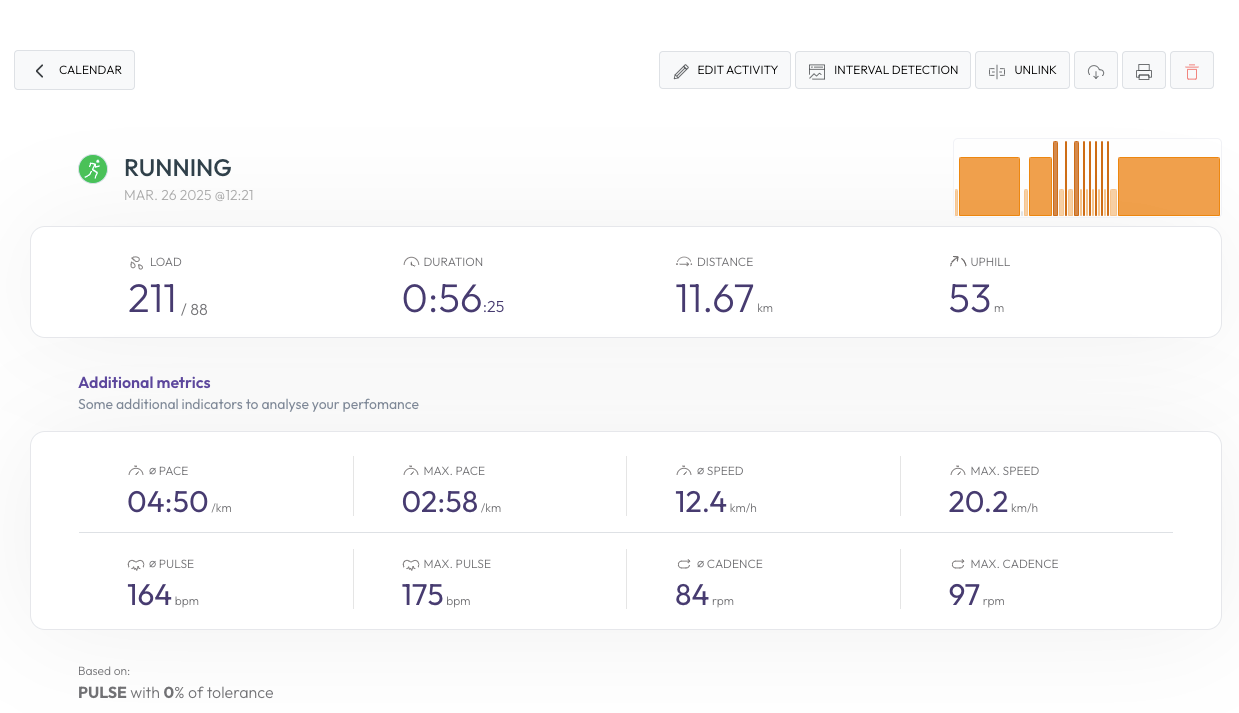
The main workout metrics are summarized at the top, providing insights into duration, distance, training load, elevation gain, and other key parameters. This helps you analyze your performance at a glance.
Map Visualization

Below the workout metrics, the map shows the route of your workout, helping you visualize where and how you performed.
Detailed Intensity Graph
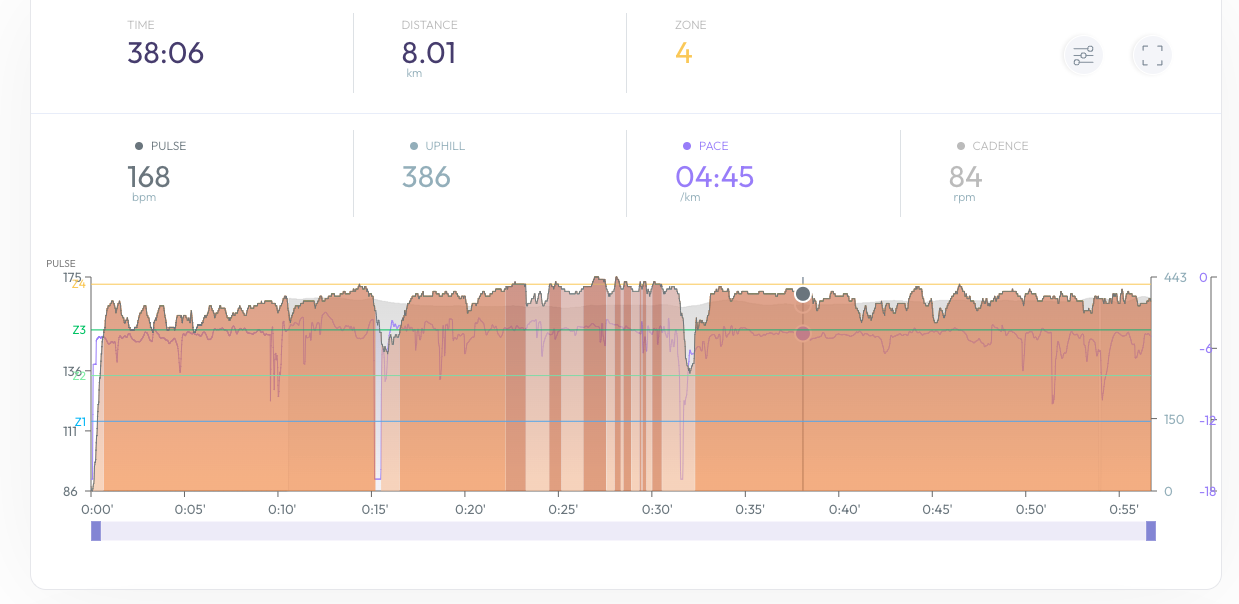
A detailed graph displays your workout’s intensity zones. By hovering over the graph, the live parameters (like heart rate, pace, or power) update dynamically. You can also focus on specific segments by adjusting the purple bar beneath the graph. Define the time frame you wish to analyze, and the graph will adapt accordingly.
Intensity Breakdown
This section compares the actual workout with the originally planned one. It shows how much time was spent in each intensity zone. If the activities are too different in nature (e.g., running vs. cycling), a meaningful comparison may not be possible.
Best Splits
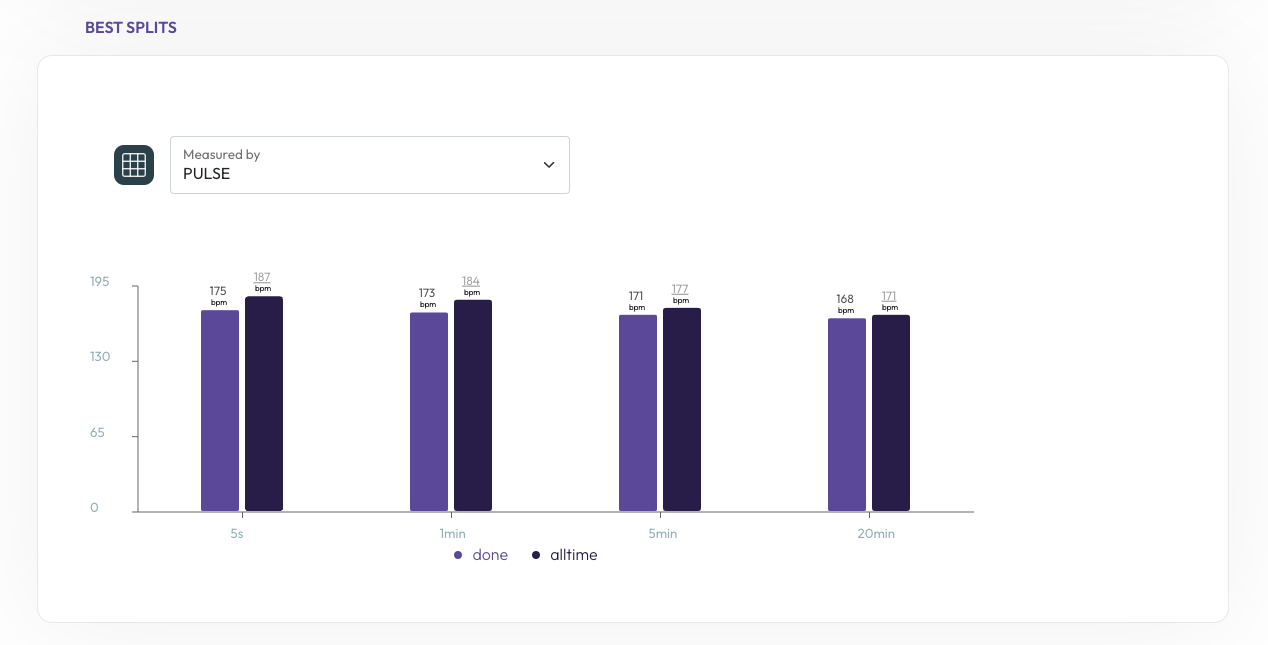 At the end, a graph highlights your best splits for different time intervals (e.g., 5 seconds, 1 minute, 20 minutes). You can compare these with your historical bests to evaluate your progress and performance in this specific workout.
At the end, a graph highlights your best splits for different time intervals (e.g., 5 seconds, 1 minute, 20 minutes). You can compare these with your historical bests to evaluate your progress and performance in this specific workout.
Training zones
Training zones are specific intensity ranges that guide your workouts to achieve targeted fitness goals. In 2PEAK, these zones are defined as follows:
- Z5 Max Power Zone: Enhances your VO₂ max potential; perform these efforts at full capacity.
- Z4 Aerobic Threshold Zone: Targets the anaerobic threshold, improving race-specific endurance.
- Z3 High Endurance Zone: Tempo training here boosts general endurance and helps maintain a high pace over extended periods.
- Z2 Basic Endurance Zone: Serves as the foundation for all training, ideal for warm-ups, cool-downs, and building aerobic endurance.
- Z1 Recovery Zone: Promotes active recovery.
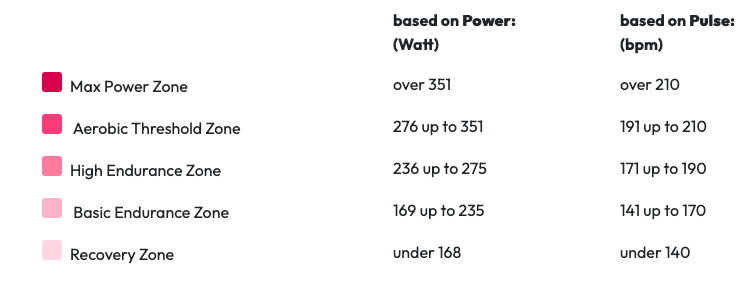
Accurately determining your personal training zones can be achieved through performance tests or by estimating based on your maximum heart rate. 2PEAK offers an automatic calculation feature that updates your zones based on recent training data, ensuring they reflect your current fitness level.
More information here: Training zones and their calculation in 2PEAK
Performance tests
Performance tests are essential tools to assess and enhance your fitness across various disciplines. Here’s a concise overview of the primary tests for cycling, running, and swimming:
Cycling: Maximum Power (MP) Test
The MP test evaluates your peak performance over durations ranging from 20 seconds to 32 minutes. MP tests over 4 minutes (preferably 8+) determine training zones, while short tests assess anaerobic abilities (sprinters, MTB cross-country). Long tests evaluate hill or time trial capacities. Conducted on inclines of at least 7%, it helps determine your power output and training zones. For durations exceeding 4 minutes, this test is particularly effective in assessing aerobic capacity.
Running: Maximum Aerobic Speed (MAS) Test
The MAS test establishes your training zones based on heart rate and speed. After a thorough warm-up, run 2000 meters at maximum effort. If you complete this distance in under 7 minutes and 30 seconds, consider increasing the distance to 3000 meters in subsequent tests. This test aids in estimating expected race times and adjusting training intensities accordingly.
Swimming: Critical Swim Speed (CSS) Test
The CSS test measures your threshold swimming pace, reflecting fatigue resistance over longer distances. After a comprehensive warm-up, perform a 400-meter maximum effort swim, rest adequately, then complete a 200-meter maximum effort swim. By entering the two times obtained in the 2PEAK CSS table, your CSS is calculated and from there your swimming training zones based on pace.
Regularly conducting these tests allows for precise monitoring of your fitness progression and enables tailored adjustments to your training regimen.
More information in our blog article: 2PEAK Performance Test
Calculators
2PEAK offers a suite of tools to enhance your training and performance analysis:
- Gear Calculator: This tool calculates your bike’s gear ratios, helping you understand the speed achievable at various cadences and gear combinations. It’s useful for optimizing gear selection based on your riding style and terrain.
- Power and Speed Calculator: This calculator estimates the power required to maintain a specific speed or, conversely, the speed attainable at a given power output. It considers factors like rider weight, bike specifications, and environmental conditions, aiding in performance planning and goal setting.
- Advantage Meter: This tool allows you to simulate how changes in variables like rider weight, bike type, wheels, helmet, clothing, number of water bottles, and threshold power affect your cycling performance. By analyzing data from previous rides, it provides personalized insights into potential time gains or losses on specific routes, helping you make informed decisions about equipment choices and training focus.
- Talent Scout: By analyzing your responses to specific questions, this feature identifies your inherent cycling talents, such as sprinting or climbing abilities. It offers personalized recommendations to develop and leverage these strengths effectively.
- Mental Strength Profile: This assessment evaluates your psychological resilience and mental strategies in training and competition. Understanding your mental strengths and areas for growth can enhance focus, motivation, and overall performance.
Utilizing these tools can provide a comprehensive understanding of both your physical and mental capabilities, enabling a more tailored and effective training approach.
How much should I train?
Determining the optimal training frequency depends on several key factors:
- Personal Schedule and Commitments
Assess your daily responsibilities to identify consistent time slots for training. Regularity is crucial, so consider whether you can train in the morning, during lunch breaks, or in the evening. Ensure that your training schedule aligns with your lifestyle to maintain consistency.
- Training Goals
Your objectives significantly influence how often you should train:
- General Health: If your aim is overall well-being, 2 to 3 sessions per week may suffice. Incorporating activities like Pilates or strength training can enhance your fitness routine.
- Performance Enhancement: For those seeking to maximize athletic potential, a higher training volume is necessary. Many dedicated athletes train around 10 hours per week, with some incorporating two sessions in one day to fully leverage their potential.
- Target Event Distance
The nature of your main event also dictates training frequency:
- Short Races: Effective results can be achieved with less than 10 hours of training per week. Frequent, shorter, and intense sessions are beneficial for time-constrained athletes.
- Long-Distance Events: Preparing for longer races requires incorporating longer training sessions to build endurance.
- Recovery and Rest
Balancing training load with adequate recovery is essential to prevent overtraining and promote improvement. Incorporate rest days or light workouts into your schedule, and adjust based on factors like age, training experience, and overall stress levels.
- Individual Considerations
Account for personal factors such as injury history and the specific demands of your sport. If prone to injuries, consider reducing training volume or integrating alternative activities to maintain fitness while allowing recovery.
By evaluating these aspects, you can tailor a training schedule that aligns with your personal circumstances and goals, ensuring both effectiveness and sustainability.
More information in our blog article: How often should I train?
Training by pulse, pace, or watt?
When structuring your training, selecting the appropriate metric—heart rate, pace, or power—depends on your sport and training objectives. Here’s a breakdown to guide your choice:
Heart Rate
Monitoring heart rate is beneficial for gauging cardiovascular effort, especially during steady-state aerobic sessions. However, heart rate can be influenced by external factors like temperature, hydration, and fatigue, which may affect its reliability for high-intensity or interval training.
Pace
Pace is a straightforward metric for runners, offering immediate feedback on speed. It’s particularly useful for maintaining consistent effort during tempo runs or races. However, terrain and environmental conditions can impact pace, making it less reliable in varied settings.
Power
Power measurement, especially in cycling, provides a direct assessment of the work being performed, independent of external conditions. This makes it a precise tool for managing training intensity, particularly during intervals and high-intensity efforts. For runners, power meters are becoming more accessible, offering similar benefits.
Recommendation
For steady-state, aerobic training, heart rate monitoring is effective. For activities where pace is a critical factor, such as running, pace monitoring is beneficial. For high-intensity or interval training, especially in cycling, power measurement is the most reliable metric. Advanced athletes may benefit from integrating multiple metrics to gain a comprehensive understanding of their performance.
Regularly assessing your training zones through performance tests can enhance the accuracy of your chosen metric, ensuring your training remains effective and aligned with your goals.


